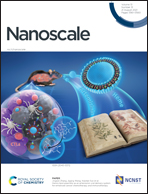Moiré patterns of twisted bilayer antimonene and their structural and electronic transition†
Abstract
Interlayer twisting in two-dimensional (2D) van der Waals (vdW) heterostructures often leads to a periodic moiré pattern which is a superlattice structure on top of the original atomic lattice of the 2D layers. The formation of a moiré superlattice can be accompanied by a significant structural reconstruction and ultra-flat electronic bands. The moiré superlattice is typically built with a tunable scale by controlling the rotation angle θ between the individual 2D layers. In this paper, we report the structural reconstruction and electronic transition in moiré patterns of twisted bilayer antimonene, based on Kohn–Sham density functional theory calculations. Starting from rigid moiré structures, the atomic relaxation leads to an array of high-symmetry stacking domains with soliton boundaries through a vortex-like reconstruction. For twist angle θ ≤ 6.01°, the impact of the structural reconstruction on the electronic bands becomes very significant, in the appearance of flat bands at the valence band edge, and no magic angle is required for the flat bands to appear in the 2D Sb moiré patterns. Both inhomogeneous interlayer hybridization and local strain are found to be responsible for the formation of these flat electronic bands.



 Please wait while we load your content...
Please wait while we load your content...